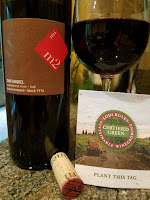 The success of wineries within Sonoma's Dry Creek Valley is completely intertwined with the vision and determination of a founding winery, Dry Creek Vineyard. This is shown in the foresight of founder David S. Stare who moved his family from New England to Sonoma County where in the early 1970s he purchased "a rundown 55-acre prune orchard across the street from the Dry Creek General Store". On this site he started planting the region's first vines since prohibition -- one of these against the advice of "experts" and the love of the Loire Valley -- Sauvignon Blanc. This lead to the first Sonoma County wine labelled Fume Blanc and soon afterwards their Chenin Blanc was highly respected and served at White House dinners.
The success of wineries within Sonoma's Dry Creek Valley is completely intertwined with the vision and determination of a founding winery, Dry Creek Vineyard. This is shown in the foresight of founder David S. Stare who moved his family from New England to Sonoma County where in the early 1970s he purchased "a rundown 55-acre prune orchard across the street from the Dry Creek General Store". On this site he started planting the region's first vines since prohibition -- one of these against the advice of "experts" and the love of the Loire Valley -- Sauvignon Blanc. This lead to the first Sonoma County wine labelled Fume Blanc and soon afterwards their Chenin Blanc was highly respected and served at White House dinners.  In the 1980s, Stare was instrumental in obtaining the American Viticulture Area (AVA) status for Dry Creek Valley and immediately was the first winery to label their wines from this AVA. Thus their labels became somewhat iconic honoring the New England sailboat culture and Dry Creek Valley viticulture.
In the 1980s, Stare was instrumental in obtaining the American Viticulture Area (AVA) status for Dry Creek Valley and immediately was the first winery to label their wines from this AVA. Thus their labels became somewhat iconic honoring the New England sailboat culture and Dry Creek Valley viticulture.  In the late 1980s, daughter Kim Stare Wallace joined the winery as director of marketing together they drove more innovation. The winery was the founding member of the Meritage Foundation and was the first to use the phrase "old-vine" for Zinfandel vines planted before Prohibition. After joining the team, husband Don Wallace pioneered the California Sustainable Winegrowers Program which eventually lead to the winery becoming 100% Certified Sustainable in 2014. Around the same time the couple changed the winery's philosophy by "dramatically reducing production while increasing quality and sharpening the focus on appellation-driven, terroir-focused wines that rival the best in California". The wines we sampled at our visit as part of the BevFluence Sonoma Experience reflect this philosophy.
In the late 1980s, daughter Kim Stare Wallace joined the winery as director of marketing together they drove more innovation. The winery was the founding member of the Meritage Foundation and was the first to use the phrase "old-vine" for Zinfandel vines planted before Prohibition. After joining the team, husband Don Wallace pioneered the California Sustainable Winegrowers Program which eventually lead to the winery becoming 100% Certified Sustainable in 2014. Around the same time the couple changed the winery's philosophy by "dramatically reducing production while increasing quality and sharpening the focus on appellation-driven, terroir-focused wines that rival the best in California". The wines we sampled at our visit as part of the BevFluence Sonoma Experience reflect this philosophy. 2022 Clarksburg Dry Chenin Blanc ($17)
Dry Chenin Blanc has been a regular release from the winery since their inception in 1972. This is a classic Loire Valley-style wine with complex, mouth watering acidity and minerality with surprisingly abundant texture.
2023 Dry Creek Valley Sauvignon Blanc ($25)
This wine incorporates two Sauvignon Blanc clones - Sauvignon Musqué and Sauvignon Gris - that are farmed in several distinct vineyard sites. It's another complex wine and original 1972 offering with lemongrass and floral aromas transitioning to a more tropical profile.
2023 Dry Creek Valley Petite Zin Rosé ($32)
This rosé is predominately Zinfandel with a small addition of Petite Sirah with the grapes lightly pressed and cold fermented. Floral, lime, herbaceous with a refreshing finish.
2021 Sonoma County Heritage Vines Zinfandel ($28)
The wine is labeled "Heritage Cines" as cuttings from pre-Prohibition era Zinfandel vines were grafted onto phylloxera-resistant rootstock. These vines were then propagated to four vineyards to ensure a virus-free and healthy crop. This was a group favorite and noticeable for its tremendous value. Loads of dark fruit, light pepper, some baking spices, and earthiness. Love the acidity.
2020 Dry Creek Valley Beeson Ranch Zinfandel ($55)
The Beeson Ranch was planted in the late 1800s and is one of Dry Creek Valley’s oldest and most prized vineyards. Located along West Dry Creek Road, Beeson Ranch faces east and extends up several gentle hillsides to a forest of conifer trees. The old gnarled Zinfandel vines, first planted by Italian immigrants, produce a most interesting wine. Consumers are inundated with complex notes within a vast range of dark fruit, spices, and earthy qualities. Drink now or let the acids work for a few years.
2019 Dry Creek Valley The Mariner ($55)
The Mariner showcases the winery's New England heritage and Meritage foundation. The grapes for are derived from several prized estate and hillside vineyards in the Dry Creek Valley. The wine explodes in the mouth, generating tides of complex flavors with dark cherries, mocha, and herbaceous notes standing out. Another to drink now, but better to be patient for later consumption.
2019 Dry Creek Valley Endeavour Cabernet Sauvignon ($100)
The Endeavour Vineyard is located in the Lytton Springs district of Dry Creek Valley and the vines take advantage of the diverse soil conditions on the property. This is a world-class wine, already sitting for a number of years in the bottle where additional aging will not destroy the structured tannins and complexity.












































